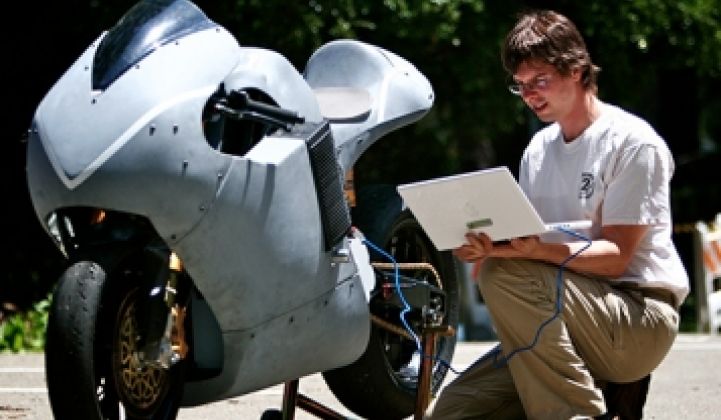There's no point in trying to do this alone, Mission Motors has concluded.
The electric motorcycle manufacturer has decided to take a bifurcated approach to the market, new interim CEO Jit Bhattacharya told us this morning. (Bhattacharya and I will speak at the U.S.-Japan Clean Tech Symposium in San Francisco tomorrow. Click the link for more.)
Mission will produce a high-end, high-performance motorcycle under its own name, but it will also produce batteries, drive-train systems and other components for large, established manufacturers, he said. The company, founded by Tesla Motors alums, has already inked a memorandum of understanding with Zongshen, China's largest motorcycle manufacturer, to supply Zongshen with components for electric motorcycles. It is also talking to established motorcycle manufacturers in the U.S. and is eyeing the Japanese market.
By becoming a supplier of intellectual property, software and components, Mission ideally will be able to skirt some of the more onerous tasks facing any new entrant into the transportation market: building a factory, hiring employees, establishing relationships with component suppliers for thousands (as opposed to just hundreds) of parts, etc.
A number of other green companies -- including Nanostellar, 1366 Technologies, Innovalight, eSolar -- have already begun to experiment with IP strategies like licensing to increase revenue. It wouldn't be surprising if Zero Motorcycles, Brammo and the other electric cycle companies take a similar tack: despite apparent consumer interest in the U.S., the market has yet to take off like wildfire.
Most of the large manufacturers are interested in electronic transportation, Bhattacharya said, and many assume they can "just plop in a battery, plop in a motor and let's go." The reality remains much more challenging. An electric motorcycle pretty much has to be designed from scratch, so Mission's design teams will work in close collaboration with any potential partners.
Although motorcycles don't have to go through the same rigorous level of crash testing (the Department of Transportation assumes you will probably be toast in the event of an accident), electric motorcycles do present some novel design and testing challenges. The battery, for instance, has to operate and live in an environment with a fairly narrow temperature range. Furthermore, significant temperature fluctuations can impact the safety -- as well as the longevity and performance -- of the battery pack. Ambient air whooshing by at 60 miles an hour helps cool batteries, but it's not a comprehensive solution.
One of the first test markets for lithium ion two-wheelers will be China. China is already the world's largest market for electric scooters and bikes, most of which run on lead acid batteries. Lithium ion will occupy more of the market and will allow manufacturers to goose the performance of their products as battery prices decline, but it also presents the potential for mishaps.
"If you have catastrophic failures in Asia, that will affect the overall acceptance," the CEO said.
Bhattacharya, by the way, graduated from COO to interim CEO last week. Before joining Mission in 2008, he worked at design firm Ideo. Co-founder and former CEO Forrest North sits on the board of directors. A search is on for a full-time replacement.



